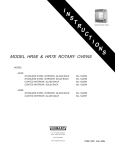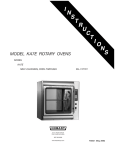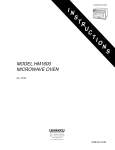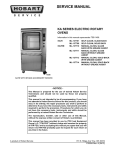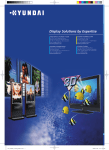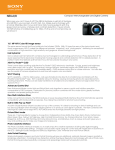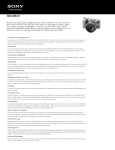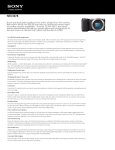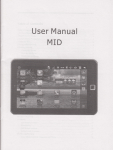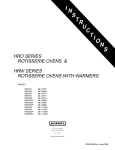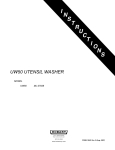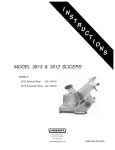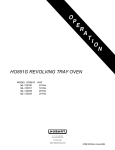Download Hobart HR7E User's Manual
Transcript
I N S T R U C T MODEL HR7E ROTARY OVEN HR7E ROTARY OVEN I O N S MODEL HR7E STAINLESS STEEL INTERIOR, GLASS BACK STAINLESS STEEL INTERIOR, SOLID BACK COATED INTERIOR, GLASS BACK COATED INTERIOR, SOLID BACK ML-132092 ML-132095 ML-132093 ML-132094 701 S. RIDGE AVENUE TROY, OHIO 45374-0001 937 332-3000 www.hobartcorp.com FORM 35508 Rev. C (May 2005) TABLE OF CONTENT GENERAL . . . . . . . . . . . . . . . . . . . . . . . . . . . . . . . . . . . . . . . . . . . . . . . . . . . . . . . . . . . . . . 3 INSTALLATION . . . . . . . . . . . . . . . . . . . . . . . . . . . . . . . . . . . . . . . . . . . . . . . . . . . . . . . . . . Location . . . . . . . . . . . . . . . . . . . . . . . . . . . . . . . . . . . . . . . . . . . . . . . . . . . . . . . . . . Legs / Casters / Stand . . . . . . . . . . . . . . . . . . . . . . . . . . . . . . . . . . . . . . . . . . . . . . Placing the Rotor in the Oven . . . . . . . . . . . . . . . . . . . . . . . . . . . . . . . . . . . . . . . . Electrical Connections . . . . . . . . . . . . . . . . . . . . . . . . . . . . . . . . . . . . . . . . . . . . . . Single Ovens / Stacked Ovens . . . . . . . . . . . . . . . . . . . . . . . . . . . . . . . . . . Before First Use . . . . . . . . . . . . . . . . . . . . . . . . . . . . . . . . . . . . . . . . . . . . . . . . . . . 3 3 3 4 5 5 5 OPERATION . . . . . . . . . . . . . . . . . . . . . . . . . . . . . . . . . . . . . . . . . . . . . . . . . . . . . . . . . . . . 6 CONTROLS . . . . . . . . . . . . . . . . . . . . . . . . . . . . . . . . . . . . . . . . . . . . . . . . . . . . . . . 6 Initial Startup . . . . . . . . . . . . . . . . . . . . . . . . . . . . . . . . . . . . . . . . . . . . . . . . . . 7 Power On . . . . . . . . . . . . . . . . . . . . . . . . . . . . . . . . . . . . . . . . . . . . . . . . . 7 Idle Mode . . . . . . . . . . . . . . . . . . . . . . . . . . . . . . . . . . . . . . . . . . . . . . . . . 7 Setting the Clock . . . . . . . . . . . . . . . . . . . . . . . . . . . . . . . . . . . . . . . . . . . 7 Changing Temperature Readings to Celsius . . . . . . . . . . . . . . . . . . . . . 7 Saving or Verifying a Cook Program (Program 1 – 99) . . . . . . . . . . . . . . . . . 8 Programmed Cooking (Program 1 – 99) . . . . . . . . . . . . . . . . . . . . . . . . . . . 10 Manual Cooking (Program 0) . . . . . . . . . . . . . . . . . . . . . . . . . . . . . . . . . . . . 11 Holding Cycle (Silencing the 'End of Cycle' Alarm . . . . . . . . . . . . . . . . . . . 12 Stopping a Cycle . . . . . . . . . . . . . . . . . . . . . . . . . . . . . . . . . . . . . . . . . . . . . . 12 Pausing a Cycle . . . . . . . . . . . . . . . . . . . . . . . . . . . . . . . . . . . . . . . . . . . . . . . 12 99 Program Feature . . . . . . . . . . . . . . . . . . . . . . . . . . . . . . . . . . . . . . . . . . . . 13 Operator ID Feature . . . . . . . . . . . . . . . . . . . . . . . . . . . . . . . . . . . . . . . . . . . 13 Adding Cook Time . . . . . . . . . . . . . . . . . . . . . . . . . . . . . . . . . . . . . . . . . . . . . 13 Suggested Roasting Guidelines . . . . . . . . . . . . . . . . . . . . . . . . . . . . . . . . . . 14 Entering Recipe Data . . . . . . . . . . . . . . . . . . . . . . . . . . . . . . . . . . . . . . . . . . 14 Preparing, Tying & Spitting — Chickens on V-Spits . . . . . . . . . . . . . . . 16 Incorrect Spitting — Chickens on V-Spits . . . . . . . . . . . . . . . . . . . . . . . 17 Spitting — Chickens on Fork Spits . . . . . . . . . . . . . . . . . . . . . . . . . . . . . 18 Loading — Chickens on Racks . . . . . . . . . . . . . . . . . . . . . . . . . . . . . . . 18 Loading — Chicken Pieces in Baskets . . . . . . . . . . . . . . . . . . . . . . . . . 18 Loading Accessories on the Rotor . . . . . . . . . . . . . . . . . . . . . . . . . . . . . 18 Loading V-Spits on the Rotor . . . . . . . . . . . . . . . . . . . . . . . . . . . . . . . . . 19 Loading Fork Spits on the Rotor . . . . . . . . . . . . . . . . . . . . . . . . . . . . . . 19 Loading Chicken Racks or Baskets on the Rotor . . . . . . . . . . . . . . . . . 19 Personal Protective Equipment . . . . . . . . . . . . . . . . . . . . . . . . . . . . . . . . . . 20 Unloading Accessories From Oven . . . . . . . . . . . . . . . . . . . . . . . . . . . . . . . 20 Emptying the Grease Drawer . . . . . . . . . . . . . . . . . . . . . . . . . . . . . . . . . . . . 20 CLEANING . . . . . . . . . . . . . . . . . . . . . . . . . . . . . . . . . . . . . . . . . . . . . . . . . . . . . . . Cleaning Stainless Steel Surfaces . . . . . . . . . . . . . . . . . . . . . . . . . . . . . . Cleaning the Grease Drawer . . . . . . . . . . . . . . . . . . . . . . . . . . . . . . . . . . . Cleaning Quartz Lamps . . . . . . . . . . . . . . . . . . . . . . . . . . . . . . . . . . . . . . . Cleaning Guidelines for Nonstick Coated Surfaces . . . . . . . . . . . . . . . . . How To Clean Nonstick Coated Surfaces . . . . . . . . . . . . . . . . . . . . . Cleaning the Temperature Probe . . . . . . . . . . . . . . . . . . . . . . . . . . . . . . . Monthly Cleaning . . . . . . . . . . . . . . . . . . . . . . . . . . . . . . . . . . . . . . . . . . . . 21 21 21 21 22 22 22 23 MAINTENANCE . . . . . . . . . . . . . . . . . . . . . . . . . . . . . . . . . . . . . . . . . . . . . . . . . . . . . . . . 24 TROUBLESHOOTING . . . . . . . . . . . . . . . . . . . . . . . . . . . . . . . . . . . . . . . . . . . . . . . . . . . 24 Service . . . . . . . . . . . . . . . . . . . . . . . . . . . . . . . . . . . . . . . . . . . . . . . . . . . . . . . . . . 24 © HOBART 2005 –2– Installation, Operation and Care of MODEL HR7E ROTARY OVENS SAVE THIS MANUAL FOR FUTURE REFERENCE GENERAL The model HR7E Oven is a seven-spit rotary oven that features a full view tempered glass door and quartz lighting that promote visual appeal and stimulate customer interest. The solid back model is used when the oven is positioned against a wall. The glass back model provides an identical rear glass for customer viewing; with the handle kit accessory the rear glass can be used for pass-through operation. The HR7E rotary oven is available with stainless steel or nonstick coated interior for ease of cleaning. The oven’s grease drawer has a drain valve for elimination of excess fat; the grease drawer can be completely removed for cleaning. The oven provides evenly cooked and appealingly roasted product with combination convection and radiant heat. ACCESSORIES Type of Spit Qty Whole Chicken Capacity V-Spit 7 21 - 28 Thermo-Wave Spit 7 21 - 28 Meat Fork Spit 7 28 - 35 5-Position Rack 7 35 4-Position Rack 7 28 Baskets 7 NA Only one type of accessory is intended to be used in the oven at a time. Do not mix accessory types. INSTALLATION Immediately after unpacking the oven, check for possible shipping damage. If the oven is found to be damaged, save the packaging material and contact the carrier within 15 days of delivery. Prior to installation, test the electrical service to assure that it agrees with the specifications on the machine data plate located behind the left-hand hinged door. LOCATION The oven must be installed on a level surface. The installation location must allow adequate clearances for servicing and for proper operation). Minimum clearance for sides and back is 0.0" (0.0 cm). LEGS / CASTERS / STAND Each oven is furnished on 1 11⁄16" (4.3 cm) legs. Casters are included with the stacking kit accessory. A caster-equipped stand with convenient storage drawer is available; the oven is mounted on top of the stand. Tethering is required for units on a stand or stacked when equipped with casters. Refer to the Stand or Stacking Kit Instructions. –3– PLACING THE ROTOR IN THE OVEN The rotor must properly engage with the drive mechanism. Orient the rotor so that the end plate with square drive slots is on the same side of the oven as the drive arm. STEP 1: Stop the drive arm so it is in the down position (Fig. 1). Fig. 1 STEP 2: Place the rotor shaft onto upper notch of support bearing on the non-drive side of the oven (Fig. 2). Fig. 2 STEP 3: Place the drive side of the rotor shaft on the drive arm support notch (Fig. 3). Fig. 3 STEP 4: Turn the rotor, lining up the square drive slots on the rotor end plate with the pins on the drive arm (Fig. 4). STEP 5: Nudge rotor toward the drive arm. Non-drive end of rotor shaft falls into the lower portion of support bearing hub (Fig. 5). Drive end of rotor shaft is driven into center hole of drive arm. Fig. 4 STEP 6: Rotor is now in normal operating position (Fig. 6). MOTOR DRIVE PINS THROUGH DRIVE SLOTS ON ROTOR END PLATE Fig. 5 Fig. 6 –4– ELECTRICAL CONNECTIONS WARNING: ELECTRICAL AND GROUNDING CONNECTIONS MUST COMPLY WITH THE APPLICABLE PORTIONS OF THE NATIONAL ELECTRICAL CODE AND / OR OTHER LOCAL ELECTRICAL CODES. WARNING: DISCONNECT ELECTRICAL POWER TO THE MACHINE AND FOLLOW LOCKOUT / TAGOUT PROCEDURES. Single Oven Access the electrical connection point by removing the side panel where the controls are located. Make sure that the electrical power supply agrees with the specifications on the oven data plate and complies with the wiring diagram located on the inside of the side panel. Stacked Ovens Refer to the Stacking Kit Installation Instruction included with the stacking kit. Attach the power supply conduit to bottom of oven. Connect the power supply to the terminal block as shown on the wiring diagram. Inspect and check all wiring and terminal connections for tightness and proper routing away from any moving parts or pinch points. Carefully replace side panels. ELECTRICAL DATA HR7E HR7E / HR7E * VOLTAGE 208 HZ 60 PHASE 3 AMPERAGE 25.8 WATTAGE 9300 AMPERAGE 51.6 240 208 60 60 3 1 22.4 44.7 9300 9300 44.8 NA** 240 60 1 38.8 9300 NA** * Stacked units can be wired independently or with single point connection using the stacking kit accessory. ** Single point connection is not available for stacked HR7E / HR7E single phase units. THREE PHASE CONNECTION — 208V or 240V TB1 1 2 3 4 3 31 7 4 9 61 1 2 3 31 7 1 2 3 4 5 8 9 10 11 12 1 2 3 5 6 7 5 6 SINGLE PHASE CONNECTION — 208V or 240V 1 2 3 L1 L2 L3 TB1 4 4 6 7 8 5 6 61 9 10 11 12 1 2 3 L1 L2 L3 BEFORE FIRST USE WARNING: DISCONNECT ELECTRICAL POWER TO THE MACHINE AND FOLLOW LOCKOUT / TAGOUT PROCEDURES BEFORE CLEANING OR SERVICING. Oven must be burned in to release any odors that might result from heating the new oven surfaces. 1. Clean oven and accessories, both inside and outside. Refer to CLEANING, pages 21 — 23, for further instructions. 2. Operate oven at maximum temperature setting of 482°F (250°C) for 45 minutes. Smoke with an unpleasant odor will normally be given off during this burn-in period. –5– OPERATION WARNING: HOT GLASS, GREASE AND PARTS CAN CAUSE BURNS. USE CARE WHEN OPERATING AND SERVICING THE OVEN. CONTROLS (Fig. 7) MAIN POWER SWITCH ON PROGRAM — Enters program mode to modify a cook program; press P for 3 seconds. CLOCK — Sets the clock for time of day. PROBE — Displays temperature, external meat probe. ADD 5 MIN — Adds 5 minutes to current step of program in process each time it is pressed. START START — Begins cooking cycle. STOP STOP — Stops cycle. SILENCE — Silences beeper. ROTATE — Rotor on/off, pauses cooking cycle. CLEAR CLEAR — Clears time or temperature entry . ENTER ENTER — Accepts time or temperature entry. 0—9 — Enter numeric value(s). t — Service use only. P OFF CLOCK TEMPERATURE PROGRAM TIME •F •C STEP t 1 • 2 • 3 4 • • • AM • PM P 7 8 9 START CLOCK 4 5 6 STOP 1 2 3 CLEAR 0 ENTER ADD 5 MIN — Turns oven and controls on or off. ADD 5 MIN 0 1 2 3 4 5 6 7 8 9 Fig. 7 –6– INITIAL STARTUP Power On Toggle the Main Power switch on the front panel of the oven to the ON position; the red indicator light on the switch comes on (Fig. 5). Idle Mode When the oven is first turned on, the display shows the time of day and the last operated program number. Any programmed steps for the selected program are indicated by illuminated step LEDs. The interior oven lights are off. Setting the Clock The oven's clock is preprogrammed for 12-hour operation as standard. The oven can be reprogrammed for 24-hour operation by your local Hobart Service office. TEMPERATURE 9:2 5 • F •C PROGRAM P0 P Begin from idle mode. TIME STEP 3 t 2o • 4 • 1o 7 8 AM PM To set the time of day, press ADD 5 MIN . The time display goes blank. The PM light blinks. • Enter the time of day (HH:MM) using the number keys. 9 START • Press CLOCK CLOCK 4 5 6 1 2 3 CLEAR 0 ENTER STOP CLOCK to toggle A.M. or P.M. (not necessary if clock is programmed for 24-hour operation). • Press ENTER to accept a valid entry. The control returns to idle mode. • If an nonvalid value such as 10:95 is in the time display when ENTER is pressed, the beeper sounds twice and the time display goes blank. Changing Temperature Readings to Celsius The oven is preprogrammed for temperatures to read in Fahrenheit degrees as standard. The oven can be reprogrammed for Celsius temperature readings by your local Hobart Service office. –7– SAVING OR VERIFYING A COOK PROGRAM (PROGRAM 1 – 9) Begin from Idle Mode. Program display shows last operated program (0 – 9). EXAMPLE PROGRAM Step Step Step Step 1 2 3 4 Temperature Time 375 1:20 425 0:05 325 0:05 200 HOLd • Select a program (1 – 9). Program 0 is Manual Mode and cannot be saved into memory. • Press P for 3 seconds to enter programming mode. The program display shows the program/number being modified or verified (1 – 9). Cooking 'Step 1' LED is lit. Time display blinks. TEMPERATURE 0 TIME 1:20 • F PROGRAM •C P1 t STEP 4 3o AM PM • • Enter the desired cook time from 0:01 (1 minute) to 6:00 (6 hours). • Press ENTER to accept (or, press CLEAR to void and reenter). 2o 1 An invalid entry produces a double beep. Entering 0:00 for the time turns step 1 off and skips to step 2. Temperature display blinks. TEMPERATURE 375 TIME 1:20 F PROGRAM •C P1 t STEP 4 3o • • AM • PM • Enter the desired cook temperature from 180 to 482 (degrees Fahrenheit). • Press 2o ENTER to accept (or, press CLEAR to void and reenter). An invalid entry produces a double beep. 1 Cooking 'Step 2' LED is lit. Time display blinks. TEMPERATURE 0 PROGRAM P1 TIME AM 0:05 F •C STEP 4 3o t 1 • • PM • Enter the desired cook time from 0:01 (1 minute) to 6:00 (6 hours). • Press ENTER to accept (or, press CLEAR to void and reenter). An invalid entry produces a double beep. 2 Entering 0:00 for the time turns step 2 off and skips to step 3. Temperature display blinks. TEMPERATURE 425 PROGRAM P1 TIME 0:05 F • C STEP 4 3o t 1 2 • • AM • PM • Enter the desired cook temperature from 180 to 482 (degrees Fahrenheit). • Press ENTER to accept (or, press CLEAR to void and reenter). An invalid entry produces a double beep. –8– Cooking 'Step 3' LED is lit. Time display blinks. TEMPERATURE 0 TIME PROGRAM •C P1 t AM 0:0 5 F STEP 2o 4 3 • • PM • Enter the desired cook time from 0:01 (1 minute) to 6:00 (6 hours). • Press ENTER to accept (or, press CLEAR to void and reenter). An invalid entry produces a double beep. 1 Entering 0:00 for the time turns step 3 off and skips to step 4. Temperature display blinks. TEMPERATURE 325 TIME 0:0 5 F PROGRAM •C P1 t STEP 2o 4 3 • • AM • PM • Enter the desired cook temperature from 180 to 482 (degrees Fahrenheit). • Press ENTER to accept (or, press CLEAR to void and reenter). 1 An invalid entry produces a double beep. HOLd 'Step 4' LED is lit. Time displays HOLd. 'HOLd' time is infinite and cannot be set. TEMPERATURE 200 TIME F PROGRAM •C P1 t HOLd STEP 3 • AM • PM 4 2 Temperature display blinks. • Enter the desired Hold temperature from 140 to 230 (degrees Fahrenheit). An invalid entry produces a double beep. 1 An entry of 000 for the temperature turns HOLd off. • Press ENTER to accept (or, press CLEAR to void and reenter). An invalid entry produces a double beep. TEMPERATURE TIME 9:30 F PROGRAM •C P1 t STEP 1 2 3 4 AM • PM The controller returns to Idle Mode, any programmed steps for the selected program are indicated by illuminated LEDs. Step 1 LED is lit – indicates cook step 1 is programmed. Step 2 LED is lit – indicates cook step 2 is programmed. Step 3 LED is lit – indicates cook step 3 is programmed. Step 4 LED is lit – indicates HOLd, step 4, is programmed. No Step LEDs are lit — program is cleared. –9– PROGRAMMED COOKING (Program 1 – 9) Begin from Idle Mode. The Program display shows the last operated program (0 – 9). TEMPERATURE PROGRAM •C P1 t STEP 1 TEMPERATURE PROGRAM 1 AM 9:30 F 375 • TIME 2 3 4 STEP 4 3o t 2o 1 START to run a preprogrammed cook cycle. While running a cooking program . . . 1:30 •C Any programmed steps for the selected program are indicated by lit step LEDs. • Press TIME F • PM Select a saved cook program (1 – 9). • • AM • PM The controller displays the number of the program in operation. The LED for the cook step currently in process blinks. The temperature setting of the cook step in process displays. The total combined cook time (for all programmed steps) displays. The time colon blinks to indicate time is counting down. Both oven lights come on (one light will cycle on and off with the thermostat's demand for heat). Heaters and fans come on. – 10 – MANUAL COOKING (Program 0) Begin from Idle Mode. The Program display shows the last operated program (0 – 9). • Select manual mode by selecting program 0: [0, ENTER]. TEMPERATURE 0 Cook Step 1 LED is lit. Time display blinks. TIME 1:30 F PROGRAM •C P0 t STEP AM • PM • Enter the desired cook time from 0:01 (1 minute) to 6:00 (6 hours). 4 3 • Press 2 ENTER to accept (or, press CLEAR to void and reenter). 1 An invalid entry produces a double beep. An entry of 0:00 for the time clears manual mode settings and returns contol to idle mode. TEMPERATURE 375 Temperature display blinks. TIME 1:30 F PROGRAM •C P0 t STEP AM • PM 4 3 • Enter the desired cook temperature from 180 to 482 (degrees Fahrenheit). • Press 2 1 ENTER to accept (or, press CLEAR to void and reenter). An invalid entry produces a double beep. TEMPERATURE 200 PROGRAM HOLd, Step 4 LED, is lit. HOLd displays in the Time display. TIME F •C 0 HOLd STEP 3 t • AM • PM 4 (Steps 2 and 3 are not available in manual mode.) HOLd time is infinite and cannot be set. Temperature display blinks. 2 • Enter the desired HOLd temperature from 140 to 230 degrees Fahrenheit. 1 An invalid entry produces a double beep. An entry of 000 for the temperature turns HOLd off. • Press ENTER to accept (or, press CLEAR to void and reenter). An invalid entry produces a double beep. TEMPERATURE PROGRAM P0 Controller returns to Idle Mode, Manual Mode 'step' LEDs are lit. TIME 9:30 F • C STEP AM If Step 1 LED is lit — it indicates Cook only. • PM If Step 1 & Step 4 LEDs are lit — it indicates Cook & Hold. 4 3 t If no Step LEDs are lit — it indicates Manual Mode is cleared and that no steps have been entered. 2 1 Press TEMPERATURE 375 TIME 1:30 F PROGRAM •C P0 t STEP 4 3 2 1 AM • PM START to run Manual Cook cycle (Program 0). While running the manual cook cycle . . . The controller displays program number 0. The LED for the cook step currently in process blinks. The cook temperature of the cook step in process displays. The cook time displays and begins to count down. Both oven lights come on (one of them cycles on and off). Heaters and Fans come on. – 11 – HOLDING CYCLE (SILENCING THE 'END OF CYCLE' ALARM) TEMPERATURE 325 PROGRAM TIME 0:0 0 F •C 1 STEP t 2o PROGRAM After a cook cycle has been completed, the beeper sounds and the oven automatically executes the Hold cycle (Step 4 of the cooking program). 4 The Hold cycle will not execute if it was programmed 'off', using Hold Temp = 000. 1 TEMPERATURE 200 3 • AM • PM TIME F •C H 11:00 STEP t 2o 3 AM • PM 4 to silence the beeper. • Press • Program displays "H" to indicate that the oven is in a Hold cycle. • The oven retains heat during a Hold cycle. Avoid overcooking by unloading when cooking is done. 1 STOPPING A CYCLE During a Cook or Hold cycle, TEMPERATURE TIME F PROGRAM 1 • 11:05 C STEP t 1 2 3 • AM • PM • 4 Press STOP to stop the cycle. The lights, fan and heaters turn off and the controller returns to Idle Mode. If STOP is pressed after a cook cycle has been completed, the oven will not execute the Hold cycle. PAUSING A CYCLE During a Cook or Hold cycle, TEMPERATURE 425 PROGRAM 1 • TIME 1:29 F • C STEP 4 3 t • • AM • PM Press to pause the cycle. The Time and Temperature displays blink. Controller stops counting down. Heaters and Fan turn off. Interior heat lamps stay on. 2o 1 The controller beeps a reminder alarm if the cycle has been paused for over 3 minutes. • Press – 12 – to restart a cycle. ADDING COOK TIME • TEMPERATURE 325 PROGRAM 1 TIME 0:0 5 F •C STEP t 2o PROGRAM 1 • TIME 0:1 0 F •C STEP t 2o 4 3 • • AM • PM ADD 5 MIN during a cooking cycle to add 5 minutes of cook time to the current step of the program in process. Press during the end of cycle buzzer or during Hold cycle to add 5 minutes of cook time to the last step of the last operated program. Press multiple times to add as much as desired up to a maximum total cook time of 6 hours. • AM • PM 1 TEMPERATURE 325 4 3 Press • ADD 5 MIN is not active in Idle Mode after STOP has been pressed. 1 99 PROGRAM FEATURE The oven is preprogrammed with 9 programs as standard. The oven can be reprogrammed to enable all 99 programs by your local Hobart Service office. The Program display shows the last operated program (0 – 99). TEMPERATURE 325 PROGRAM 1 TIME 9:30 F •C STEP t 2o 3 • To select a program, enter the desired program number from 0 to 99. • AM • PM 4 • Program display flashes. 1 • Press ENTER to accept (or, press CLEAR to void and reenter). OPERATOR ID FEATURE The oven is preprogrammed with Operator ID "off" as standard. The oven can be reprogrammed to enable Operator ID "on" by your local Hobart Service office. TEMPERATURE 3Id PROGRAM TIME 0 F •C STEP t 2o 3 • AM • PM After main power switch is toggled on. . . Temperature displays "Id" and Time display blinks. 4 • Enter Operator ID number from from 0 to 9999. 1 • Press ENTER to accept (or, press CLEAR to void and reenter). The control returns to idle mode. – 13 – SUGGESTED ROASTING GUIDELINES The suggested cooking times and temperatures in the table may require adjustment for proper doneness depending on initial product temperature, weight, size, shape and other factors. Product Chicken, Whole, 3.0 — 3.5 lb. (1.4 — 1.6 kg) Oven Temperature Setting Cook Time HH:MM Final Internal Temperature Capacity HR7E 350 – 375 °F 1:10 to 1:30 180 – 185 °F 21 – 35 (177 – 195 °C) (82 – 85 °C) ENTERING RECIPE DATA The recipe cards, below, are provided to allow you to pencil in your own cooking recipe(s). PROGRAM # PROGRAM # TEMPERATURE TIME STEP 1 STEP 1 STEP 2 STEP 2 STEP 3 STEP 3 STEP 4 STEP 4 (HOLD) (HOLD) PROGRAM # PROGRAM # TEMPERATURE TIME STEP 1 STEP 1 STEP 2 STEP 2 STEP 3 STEP 3 STEP 4 STEP 4 (HOLD) (HOLD) – 14 – TEMPERATURE TIME TEMPERATURE TIME PROGRAM # PROGRAM # TEMPERATURE TIME STEP 1 STEP 1 STEP 2 STEP 2 STEP 3 STEP 3 STEP 4 STEP 4 (HOLD) (HOLD) PROGRAM # PROGRAM # TEMPERATURE TIME STEP 1 STEP 1 STEP 2 STEP 2 STEP 3 STEP 3 STEP 4 STEP 4 (HOLD) (HOLD) PROGRAM # PROGRAM # TEMPERATURE TIME STEP 1 STEP 1 STEP 2 STEP 2 STEP 3 STEP 3 STEP 4 STEP 4 (HOLD) (HOLD) PROGRAM # PROGRAM # TEMPERATURE TIME STEP 1 STEP 1 STEP 2 STEP 2 STEP 3 STEP 3 STEP 4 STEP 4 (HOLD) (HOLD) – 15 – TEMPERATURE TIME TEMPERATURE TIME TEMPERATURE TIME TEMPERATURE TIME PREPARING, TYING & SPITTING — CHICKENS ON V-SPITS The rotary oven is not designed to roast frozen foods. Use only fresh or previously thawed product. Bring chickens from cooler. Check temperature — range should be from 37°F to 42°F. Insert approved popper, if available; it will pop out when chicken is done. Using an approved tie, wrap around legs, pulling tie along the back, criss-cross over back. Tie comes over front holding wings to side of chicken. Insert V-Spit through neck first. The flat side of spit must be parallel with breast bone. Legs and thighs on same side as breast. Neck toward drive end Drive end Pointed end V-Spit complete with four birds ready for loading into rotisserie. Continue until all spits are completed, all birds are properly spitted. Chicken legs toward pointed end – 16 – INCORRECT SPITTING — CHICKENS ON V-SPITS ➤ WRONG — Angle of spit is in line with breast. This will split the backbone and could possibly result in falling off the spit during cooking. ➤ WRONG — Legs and thighs are not on same side as breast. This could cause legs to fall off during cooking. ➤ WRONG — Legs are being inserted first. This could result in birds moving along spits during cooking. – 17 – WARNING: SPITS ARE SHARP. USE CARE WHEN LOADING PRODUCT. SPITTING — CHICKENS ON FORK SPITS Press pointed ends of spits into whole poultry so points go through the chest-wing and leg-thigh regions (Fig. 8). Load four or five chickens on each fork spit. Fig. 8 SPITTING — CHICKENS ON THERMO-WAVE SPITS After tying chickens, insert thermo-wave spit through neck first. Load three or four chickens on each thermo-wave spit. LOADING — CHICKENS ON RACKS Place chicken cavity over spindle, legs down, neck up and breast forward (Fig. 9). Fold and cross legs; hook leg ends under side rods of rack. Break wings at top joint; fold wings behind bird. Load four- or fivechickens per rack, depending on rack. Load seven racks. Fig. 9 LOADING — CHICKEN PIECES IN BASKETS Load chicken pieces in basket in any appropriate arrangement (Fig. 10). Fig. 10 3 LOADING ACCESSORIES ON THE ROTOR • Using , load accessory into position 1, skip position 2, load position 3, etc. (Fig. 11). • Chickens must clear top of oven; no parts can stick out. • Do not mix different types of accessories on the rotor at the same time. 4 Skip 5 2 Skip 1 6 Skip 7 Fig. 11 – 18 – Loading V-Spits or Thermo-Wave Spits on the Rotor 1. Place pointed end of V-spit into small outside hole on non-drive side of rotor (Fig. 12). 2. Fit notched end of V-spit into appropriate holes on drive side of rotor (Fig. 13). 3. Make sure the spit is level. If the spit is not level, you might be using the wrong holes. NON-DRIVE SIDE DRIVE SIDE Fig. 12 Fig. 13 Loading Fork Spits on the Rotor 1. Place pointed ends of fork spit into appropriate holes on the non-drive side of the rotor (Fig. 14). 2. Fit the notched end of fork spit into appropriate holes on the drive side of the rotor (Fig. 15). NON-DRIVE SIDE DRIVE SIDE Fig. 14 Fig. 15 Loading Chicken Racks or Baskets on the Rotor Chicken Racks and Chicken Baskets hang on studs on the left and right sides of the rotor. 1. Hang the left end of a Rack or Basket on a stud on the left side of the rotor (Fig. 16). 2. Hang the right end of the Rack or Basket on the corresponding stud on the right side of the rotor at the same height (Fig. 17). The accessory must be level. NON-DRIVE SIDE DRIVE SIDE Fig. 16 Fig. 17 – 19 – PERSONAL PROTECTIVE EQUIPMENT Chickens and accessories are hot. Use care during unloading by using appropriate personal protective equipment such as 18" insulated gloves, an apron, long sleeved clothing and closed toed shoes. UNLOADING ACCESSORIES FROM OVEN Opening the door does not stop the rotor, heaters or fan. 1. Press Press STOP to stop rotation and cooking. Press to allow rotor to advance to unloading position. again to stop rotation. 2. Use insulated gloves. • Carefully remove accessory from rotor. Remove chickens from accessory. • Place chickens in proper containers. Place chicken containers in warming cabinet. 3. Repeat step 1; stagger unloading by skipping past the next accessory to the following one. 4. Repeat step 2 and 3 until unloading is complete. EMPTYING THE GREASE DRAWER Empty the grease drawer when necessary. • Use care, grease can be hot. 1. Open door. Slide grease drawer out about five inches. 2. Place a bucket or vessel large enough for the grease underneath the drain valve. 3. Open grease drain valve (Fig. 18). Close grease drain valve when drawer is empty or when container is full (Fig. 19). 4. Slide grease drawer shut. Close oven door. GREASE VALVE OPEN GREASE VALVE CLOSED Fig. 18 Fig. 19 – 20 – CLEANING WARNING: DISCONNECT ELECTRICAL POWER TO THE MACHINE AND FOLLOW LOCKOUT / TAGOUT PROCEDURES BEFORE CLEANING OR SERVICING. Proper cleaning prolongs the life and productivity of the oven. The oven should be routinely cleaned throughout the day and thoroughly cleaned at the end of the day. Allow oven to cool before cleaning. CAUTION: Do not use oven cleaners. Do not clean with a high pressure hose. 1. Wash door(s) and inside glass with warm soapy water, rinse and dry or use a commercial glass cleaner. 2. With door open, pull inside glass away from door to clean. Take extra care when cleaning outside surface of inner glass door because of its special reflective coating. Do not remove glass from door. 3. Clean control panel with a damp cloth only. 4. Remove oven rotisserie, accessories, bottom plates and other removable parts for cleaning. Refer to specific instructions below for cleaning stainless steel or nonstick coated surfaces. 5. Clean oven interior and exterior with warm soapy water. 6. Rinse interior and exterior thoroughly and dry with a soft clean cloth. CLEANING STAINLESS STEEL SURFACES 1. Wash stainless steel parts with warm soapy water. 2. Rinse parts thoroughly. 3. Dry with a soft clean cloth. CLEANING THE GREASE DRAWER 1. Empty grease drawer (refer to page 20). 2. Remove drawer when machine is idle. 3. Wash drawer in a sink with a solution of warm water and detergent. • Any hard soil can be scrubbed with a non-scratching pad or brush. • Rinse drawer and allow to dry. 5. Return drawer to drawer location. CLEANING QUARTZ LAMPS CAUTION: Do not clean the quartz lamps in the top of the oven with soap and water. Be very careful when cleaning lamps. Lamps can be broken by mishandling. • Clean lamps with a cloth soaked in alcohol. • Do Not touch lamps with your bare hands. Touching the quartz lamp could shorten the life of the bulb. – 21 – CLEANING GUIDELINES FOR NONSTICK COATED SURFACES Abrasion and aggressive chemicals reduce the life of the nonstick coating. With proper care, the nonstick coated surface should provide a long life of easy-to-clean service. DO NOT do the following: • DO NOT use abrasive cleaning aids such as steel wool. NOTE: Abrasive pads remove the coating over time, significantly reducing the life of the coating. • DO NOT use sharp instruments such as knives, forks, scrapers or metal objects of any kind. • DO NOT use agressive chemicals such as oven cleaners. NOTE: If cleaner requires gloves, it can’t be used. CAUTION: The chemical components of some cleaner/sanitizers can attack the nonstick surface causing the coating to peel. Always dilute to recommended strength. • DO NOT attempt to burn off or bake off surface contamination. • DO NOT operate more than eight hours without cleaning. How to Clean Nonstick Coated Surfaces: • Use a mild dish washing soap in warm water • Use a soft cloth or sponge to remove grease and food residue. NOTE: For heavy buildup, the only pad acceptible for use is the Scotch-Brite Power Pad 2000. • Rinse and let dry. CLEANING THE TEMPERATURE PROBE (Optional Accessory) Clean after every use. 1. Remove the probe from the probe holder located on the side of the oven. 2. Unplug probe cord from the bottom of the probe holder, if needed. Do not submerge cord in water. 3. Wipe the probe with a cloth moistened in a solution of detergent and water, rinse in clean water and allow to dry. 4. Carefully plug probe cord back into the bottom of the probe holder. (The plug pins are different sizes to ensure proper orientation.) 5. Place probe back in probe holder. 6. Dry with a soft dry cloth. 7. After cleaning, reinstall in reverse order. – 22 – MONTHLY CLEANING Clean ventilation grate and fan blades located in the top of the oven. 1. Remove ventilation grate by unscrewing nuts on both sides of vents. 2. Unscrew nut (clockwise) in center of fan blade. 3. Wash in a sink with warm soapy water. 4. Rinse thoroughly and dry with a soft dry cloth. 5. Wipe fan blades with a clean damp cloth. 6. Dry with a soft dry cloth. 7. After cleaning, reinstall in reverse order. – 23 – MAINTENANCE WARNING: DISCONNECT ELECTRICAL POWER TO THE MACHINE AND FOLLOW LOCKOUT / TAGOUT PROCEDURES BEFORE CLEANING OR SERVICING. WARNING: HOT GLASS, GREASE, AND PARTS CAN CAUSE BURNS. USE CARE WHEN OPERATING AND SERVICING THE OVEN. TROUBLESHOOTING PROBLEM POSSIBLE CAUSE 1. Control does not light up. 1. ON-OFF switch is not pressed ON. 2. Electric supply is interrupted; check circuit breaker. SERVICE Contact your local Hobart office. FORM 35508 Rev. C (May 2005) – 24 – PRINTED IN U.S.A.
























